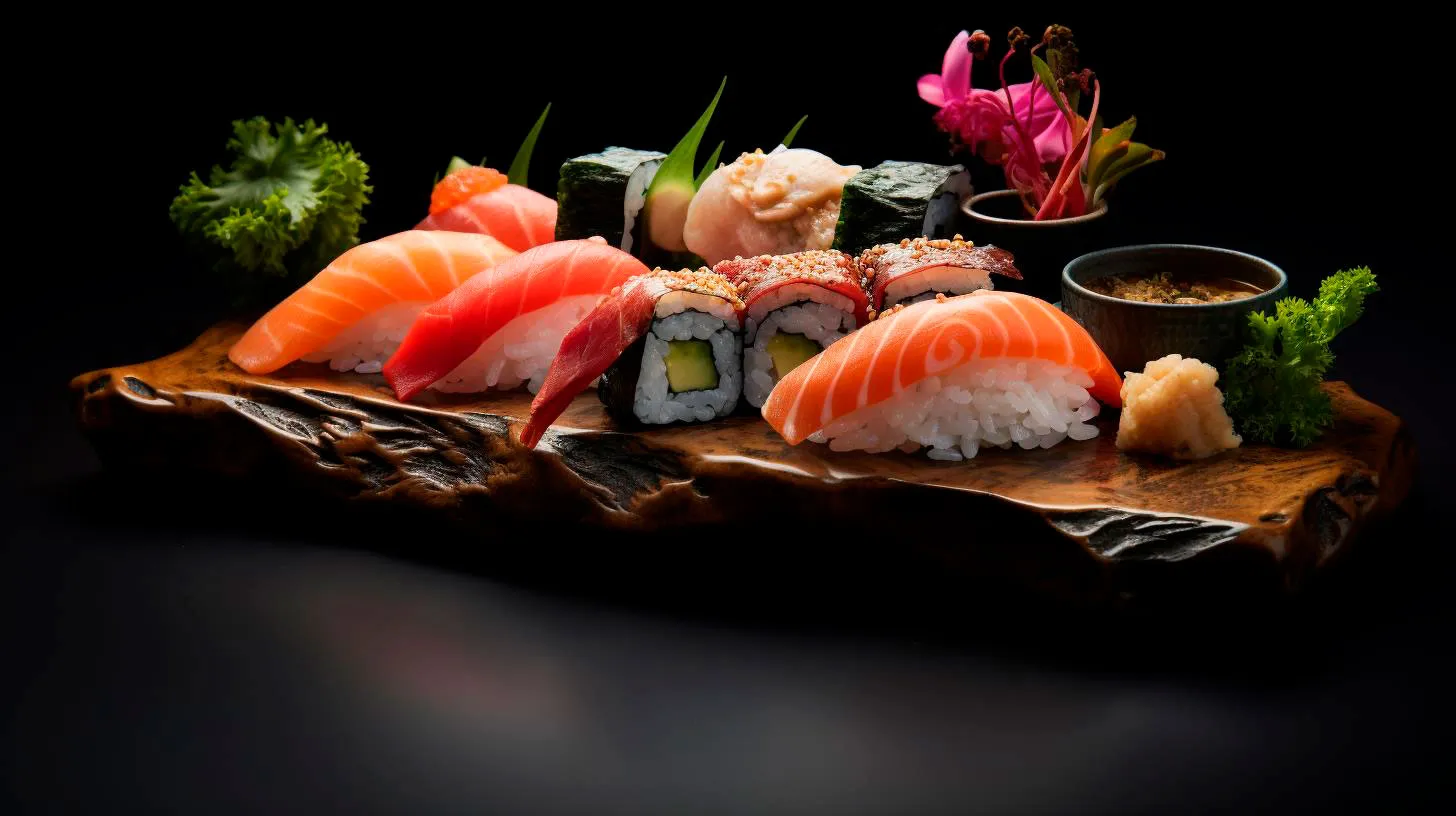The Basics of Sushi Rice Cooking Seasoning and Perfecting the Texture
In this article, we will delve into the basics of sushi rice and provide valuable tips on how to achieve that deliciously seasoned and perfectly textured sushi rice every time.
The Importance of Sushi Rice
Sushi rice, also known as shari or sumeshi, is a vital component of any sushi dish. It serves as the foundation upon which all other ingredients are delicately placed. The right balance of stickiness, chewiness, and fragrance is what sets sushi rice apart from regular steamed rice.
Key Takeaways:
- Sushi rice is the foundation of any sushi dish.
- The perfect sushi rice should have a balance of stickiness, chewiness, and fragrance.
- Proper sushi rice enhances the flavors of the other ingredients.
Cooking Sushi Rice
The first step in achieving excellent sushi rice is the cooking process. Here’s a step-by-step guide:
1. Choose the Right Rice
When it comes to sushi rice, short-grain Japanese rice is the ideal choice. Its high starch content gives the rice its characteristic stickiness. Look for brands specifically labeled as sushi rice or short-grain rice.
2. Rinse and Soak the Rice
Before cooking the rice, it is crucial to rinse it thoroughly to remove excess starch. Rinsing helps prevent the rice from becoming mushy. After rinsing, let the rice soak in water for about 30 minutes. This step ensures consistent cooking and improves the rice texture.
3. Cook the Rice
Use a rice cooker or a heavy-bottomed pot for cooking sushi rice. The rice-to-water ratio is typically 1:1.1 or 1:1.2. After draining the soaked rice, add the appropriate amount of water and cook it according to the manufacturer’s instructions. Once cooked, let the rice rest for 10-15 minutes before handling.
4. Season the Rice with Vinegar Mixture
After the rice has cooled slightly, it’s time to season it. Prepare the vinegar mixture by combining rice vinegar, sugar, and salt. Gently heat the mixture until the sugar and salt dissolve. Pour the seasoned vinegar over the cooked rice and gently fold it in using a wooden spatula or rice paddle. Be careful not to crush the rice grains.
Key Takeaways:
- Use short-grain Japanese rice for sushi.
- Rinse the rice to remove excess starch and soak it for better texture.
- Follow the recommended rice-to-water ratio for cooking.
- Season the rice with a mixture of rice vinegar, sugar, and salt.
Perfecting the Texture
Getting the right texture for sushi rice can be a bit challenging, but with practice, you can achieve perfection. Here are some tips to help you master the art of creating beautifully textured sushi rice:
1. Use the Right Rice-to-Water Ratio
The amount of water you use during cooking can significantly impact the texture of the rice. Using too much water can lead to mushy rice, while too little water can result in undercooked, hard grains. Finding the right balance is key.
2. Get the Timing Right
Timing is crucial when cooking sushi rice. Overcooking the rice can make it mushy, while undercooking will leave it hard and grainy. Follow the recommended cooking time and let the rice rest for a while after cooking to allow it to firm up slightly.
3. Get the Seasoning Right
Seasoning the sushi rice correctly is essential for flavor but also affects its texture. The vinegar mixture should be added gradually and folded in gently. Overmixing can make the rice sticky and clumpy.
4. Let the Rice Cool Properly
After seasoning, let the rice cool naturally. Rushing this process by placing it in the refrigerator can negatively affect the texture. The rice should ideally cool down to room temperature for the best results.
Key Takeaways:
- Use the correct rice-to-water ratio to achieve the desired texture.
- Pay attention to the cooking time to avoid overcooking or undercooking the rice.
- Gradually add the vinegar mixture and fold gently to avoid clumpy rice.
- Allow the rice to cool naturally to room temperature for optimal texture.
Mastering the art of sushi rice cooking and seasoning is a crucial step in becoming a sushi connoisseur. With practice and attention to detail, anyone can create beautifully textured and flavorful sushi rice right at home. Remember, the perfect sushi rice elevates the entire sushi experience, making each bite a delightful sensation.
Secrets of Japanese Sushi Chefs Techniques for Mastering Sushi Rice Perfection
In this article, we will unveil the secrets of Japanese sushi chefs and their techniques for mastering sushi rice perfection, allowing you to elevate your sushi-making skills to a whole new level.
1. Choosing the Right Rice
Japanese sushi chefs typically opt for short-grain varieties of rice such as Calrose or japonica, as they have the perfect balance of stickiness and fluffiness. This type of rice absorbs flavors well and holds together when molded into sushi rolls or nigiri. It’s essential to use high-quality rice for the best results.
Key Takeaway:
- Choose short-grain rice like Calrose or japonica for the perfect sushi rice consistency.
2. Proper Washing and Soaking
Before cooking the rice, it is crucial to wash off excess starch. Place the rice in a bowl and rinse it gently under cold water until the water runs clear. Then, let the rice soak for approximately 30 minutes. This soaking process allows the grains to absorb water evenly, leading to a more consistent texture when cooked.
Key Takeaway:
- Thoroughly wash the rice to remove excess starch for better texture.
- Soak the rice for around 30 minutes to ensure even absorption of water.
3. Achieving the Perfect Rice-to-Water Ratio
Mastering the rice-to-water ratio is crucial for perfectly cooked sushi rice. The general rule of thumb is to use a ratio of 1:1 water to rice. However, Japanese sushi chefs often adjust this ratio, considering factors such as the desired stickiness and the type of rice being used. Generally, for most sushi rice, a ratio of 1:1.1 or 1:1.2 (rice to water) works well.
Key Takeaway:
- Use a rice-to-water ratio of 1:1.1 or 1:1.2.
- Consider personal preferences for stickiness when adjusting the ratio.
4. The Importance of Seasoning
Authentic sushi rice is subtly seasoned with a mixture of rice vinegar, sugar, and salt. Japanese sushi chefs skillfully incorporate this seasoning while the rice is still warm, ensuring an even distribution of flavors. The vinegar adds a tangy brightness to complement the flavors of the sushi fillings, while the sugar and salt balance the overall taste.
Key Takeaway:
- Add a seasoned mixture of rice vinegar, sugar, and salt to the warm rice for a well-balanced flavor.
5. The Art of Rice Mixing
Mixing the seasoned vinegar into the cooked rice is a delicate process that requires a gentle, slicing motion with a wooden spatula or paddle. The goal is to evenly distribute the seasoning without crushing or overworking the rice grains. Japanese sushi chefs carefully fold the vinegar into the rice, ensuring every grain is coated with the flavorings.
Key Takeaway:
- Use a gentle slicing motion to mix the seasoned vinegar into the rice evenly.
- Avoid crushing or overworking the rice grains to maintain their texture.
6. The Final Touch: Fan Cooling
After mixing the seasoned vinegar, professional sushi chefs fan the rice to cool it down rapidly. This step helps to achieve the ideal sushi rice texture: slightly sticky, yet firm enough to hold its shape. Fan cooling prevents the rice from becoming too mushy or sticky, ensuring the perfect base for sushi creations.
Key Takeaway:
- Fan cooling the rice after mixing helps achieve the desired texture.
In Conclusion
The secrets of Japanese sushi chefs’ techniques for mastering sushi rice perfection lie in the careful selection of rice, proper washing and soaking, precise rice-to-water ratio, skillful seasoning, gentle mixing, and rapid cooling. By following these steps and practicing the art of sushi rice preparation, you can elevate your sushi-making skills and create sushi that rivals the flavors found in the best sushi restaurants.
Remember, sushi rice is the foundation of every great sushi dish. By putting these secrets into practice, you’ll be well on your way to becoming a sushi rice master.
From the Vine to the Bowl: Choosing and Preparing the Ideal Sushi Rice
So, let’s roll up our sleeves and embark on this culinary adventure!
The Importance of Sushi Rice
When it comes to sushi, the rice takes center stage. Sushi rice, or shari, forms the foundation of every sushi dish you enjoy. It’s more than just a side dish or a mere complement to the fish; it’s the very fabric that holds everything together and enhances the flavors. The perfect sushi rice is firm yet tender, sticky yet separate, and slightly sweet with a delicate hint of vinegar. Achieving this balance takes practice, but fear not! We’re here to guide you and provide some valuable insights.
Choosing the Perfect Rice
Not all rice is created equal, especially in the world of sushi. Here are a few factors to consider when selecting the best rice for your sushi:
- Short-Grain Rice: Opt for short-grain rice varieties like Japanese short-grain or sushi rice. These varieties have a higher starch content, resulting in that characteristic stickiness essential for sushi.
- Brands and Quality: Choose reputable brands known for their high-quality rice. Look for grains that are plump, white, and free from any impurities.
- Origin: Japanese-grown rice is renowned for its superior quality and taste. Providing an authentic experience, it’s worth seeking out if available in your area.
Preparing Sushi Rice
Now that you have your carefully chosen rice, it’s time to turn it into the perfect sushi rice. Here’s a step-by-step guide:
- Rinsing: Start by rinsing the rice under cold water until the water runs clear. This removes excess starch and ensures the rice doesn’t become overly sticky.
- Proportions: For every cup of rice, add one and a quarter cups of water. Use a rice cooker or a saucepan with a tight-fitting lid to cook the rice.
- Cooking: Bring the rice to a boil, then reduce the heat to low and let it simmer for about 15 minutes. Once cooked, allow the rice to sit covered for an additional 10 minutes to steam and achieve the desired texture.
- Vinegar Mixture: While the rice is cooking, prepare the vinegar mixture. In a small saucepan, combine rice vinegar, sugar, and salt. Gently heat it until the sugar and salt dissolve, then let it cool.
- Seasoning: After the rice has slightly cooled, transfer it to a wide, shallow bowl. Pour the vinegar mixture over the rice, gently folding it in with a wooden spatula. Be careful not to smash the grains.
Tips for Perfect Sushi Rice
Now that you have prepared your sushi rice, let’s take it up a notch with some expert tips:
- Ensure the rice is cooked al dente, maintaining a slight firmness to hold its shape when rolled.
- Use a wooden spatula or rice paddle to gently mix the vinegar with the rice, allowing the grains to absorb the flavors fully.
- Cover the cooked rice with a damp cloth to prevent it from drying out while you prepare your sushi fillings.
- For added depth of flavor, consider adding a sprinkle of toasted sesame seeds or finely chopped nori to your rice.
The Key Takeaways
Sushi rice is the star ingredient that can make or break your sushi experience. Remember these key takeaways:
- Choose short-grain rice varieties for that perfect sticky texture.
- Respect the quality and origin of the rice to ensure an authentic taste.
- Rinse the rice before cooking and prepare the vinegar mixture to season it properly.
- Use gentle folding motions when mixing the vinegar with the rice.
- Follow expert tips to elevate your sushi rice to the next level.
Now that you’re equipped with the knowledge to choose and prepare the ideal sushi rice, it’s time to put your skills into practice. With each grain expertly seasoned and cooked to perfection, your homemade sushi will soon rival that of your favorite sushi bar. So, go forth and conquer the art of sushi rice!
Elevate Your Sushi Game: Creative Tips and Tricks for Flavorful Rice Creations
Mastering the art of sushi rice is key to elevating your sushi game and impressing your guests. In this article, we will explore some creative tips and tricks to help you create flavorful rice creations that will leave everyone craving for more.
The Importance of Rice in Sushi Making
Before we dive into the tips and tricks, let’s understand why rice is so vital in sushi making. Sushi rice, also known as shari, is the fundamental element that holds everything together. The quality, texture, and flavor of the rice significantly impact the overall taste and enjoyment of sushi. Here are a few reasons why the rice is of utmost importance:
- Texture: Sushi rice should be sticky enough to hold its shape when rolled, ensuring that the ingredients don’t fall apart.
- Flavor: The rice adds a subtle, slightly sweet flavor that enhances the taste of the toppings and fillings.
- Bite: The rice should have a pleasant chewiness that complements the tender fish and crisp vegetables.
Tips and Tricks for Flavorful Sushi Rice
Now, let’s explore some creative tips and tricks that will help you take your sushi rice to the next level:
1. Choose the Right Rice
Not all rice varieties are suitable for making sushi. Opt for short-grain rice, such as Japanese rice or sushi rice, known for its stickiness and ability to hold together. Avoid long-grain or jasmine rice, as they have a different texture and won’t give you the desired results.
2. Rinse the Rice Thoroughly
Rinsing the rice before cooking removes excess starch, resulting in fluffier and stickier rice. Rinse the rice under cold water until the water runs clear. This will prevent the rice from becoming too gummy.
3. Achieve the Perfect Rice-to-Water Ratio
Getting the rice-to-water ratio right is crucial for achieving the perfect texture. Use 1 cup of rice to 1.25 cups of water for sushi rice. Adjust the quantity accordingly if you’re cooking a larger batch.
4. Cook with Kombu
Kombu, a type of edible kelp, adds natural umami flavors to the rice. Before cooking the rice, soak a small piece of kombu in the water. This will infuse the rice with a subtle hint of seaweed flavor, enhancing the overall taste of the sushi.
5. Season the Rice with Sushi Vinegar
Seasoning the rice is a critical step to round out the flavor profile of your sushi. Sushi vinegar, a mixture of rice vinegar, sugar, and salt, is essential for achieving the perfect balance. Gently fold the sushi vinegar into the cooked rice while it’s still warm, ensuring every grain is coated.
6. Fan the Rice to Cool
After seasoning the rice, it’s crucial to cool it down properly. Quick cooling prevents the rice from becoming mushy and maintains its sticky yet firm texture. Use a fan or a handheld fan to cool the rice while gently mixing it. This will help achieve the ideal temperature and consistency for sushi making.
Key Takeaways
By following these creative tips and tricks, you can elevate your sushi game and create flavorful rice creations that will have your guests begging for more. Here are the key takeaways from this article:
- Choose short-grain rice for sticky and cohesive sushi rice.
- Rinse the rice thoroughly to remove excess starch.
- Get the rice-to-water ratio right for the perfect texture.
- Add kombu to infuse the rice with natural umami flavors.
- Season the rice with sushi vinegar to achieve a balanced taste.
- Quickly cool the rice with a fan or handheld fan to maintain texture.
Remember, sushi making is an art that requires practice and experimentation. Don’t be afraid to put your own spin on your sushi creations and explore new flavors and ingredients. So, roll up your sleeves, gather your favorite toppings, and let your creativity shine through in your next sushi masterpiece!


